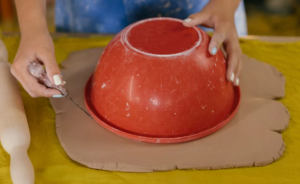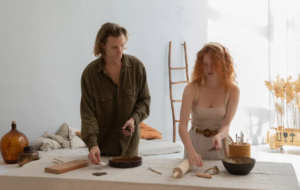Table Of Contents
- 1 Unleashing Creativity and Color: Adding Dimension to Clay Sculptures
- 1.1 Beyond Form The Meaning and Benefits of Adding Color to Clay Sculptures
- 1.2 Emotions in Action:
- 1.3 Storytelling Through Color:
- 1.4 Enhanced Depth and Dimension:
- 1.5 Individuality and Self-Expression:
- 1.6 Therapeutic Benefits:
- 1.7 A Gateway to Collaboration:
- 1.8 Techniques and Tools: Bringing Your Clay Sculptures to Life with Color
- 1.9 1. Unveiling the Palette: A Spectrum of Possibilities:
- 1.10 2. Tools of the Trade: Your Essential Color Toolkit:
- 1.11 3. Bringing Your Vision to Life: A Step-by-Step Guide:
- 1.12 4. Inspiration and Resources: Fueling Your Creative Fire:
- 1.13 5. Embracing the Journey: Enjoy the Process:
- 1.14 Conclusion and FAQs: Adding Color to Clay Sculptures
- 1.15 Key Takeaways:
- 1.16 Frequently Asked Questions (FAQs):
- 1.17 Q: What type of clay is best for adding color?
- 1.18 Q: Do I need to seal my painted clay sculpture?
- 1.19 Q: How can I prevent my colors from bleeding?
- 1.20 Q: What if I make a mistake while adding color?
- 1.21 Q: Where can I find inspiration for color combinations and techniques?
- 1.22 Conclusion:
Unleashing Creativity and Color: Adding Dimension to Clay Sculptures
Clay sculptures possess an inherent beauty and charm. However, the addition of color takes them to a whole new level, injecting life and vibrancy into their forms. Bringing color to your clay creations unlocks new avenues for expression and allows you to communicate emotions, ideas, and stories in a deeper, more impactful way.
In this introductory session, we embark on a journey to explore the fascinating world of adding color to clay sculptures. We will delve into the various methods available, discover their unique properties and benefits, and address frequently asked questions to equip you with the knowledge and confidence to embark on your own colorful creative adventure.
Get ready to unleash your inner artist, explore the boundless possibilities of color, and transform your clay sculptures into mesmerizing masterpieces!

Beyond Form The Meaning and Benefits of Adding Color to Clay Sculptures
While the addition of color undeniably enhances the aesthetic appeal of clay sculptures, its significance transcends mere aesthetics. Adding color infuses your creations with deeper meaning, allowing you to express emotions and ideas that remain hidden in the monochrome world of clay.
Emotions in Action:
Color is a powerful tool for communicating emotions. A fiery red might evoke passion and intensity, while a gentle blue instills feelings of peace and tranquility. By incorporating these colors into your sculptures, you can create a visceral response in viewers, drawing them into the emotional landscape you have crafted.
Storytelling Through Color:
Color can be used to tell stories, depict historical events, or evoke specific cultural references. For example, using earthy tones and natural textures in a sculpture can transport viewers to a serene forest landscape, while vibrant hues and geometric patterns can evoke the bustling energy of a city.
Enhanced Depth and Dimension:
Color adds depth and dimension to clay sculptures, breathing life into their forms and highlighting their intricate details. By strategically applying light and shadow effects, you can create an illusion of space and movement, making your sculptures appear more dynamic and engaging.
Individuality and Self-Expression:
Color choice is deeply personal, reflecting your unique vision and artistic style. By experimenting with different color palettes and techniques, you can express your individual personality and leave your own distinctive mark on your clay creations.
Therapeutic Benefits:
Adding color can be a meditative and therapeutic process. The repetitive motions of brushing, blending, and applying color can be calming and stress-reducing, offering a much-needed escape from daily anxieties. The act of creating something beautiful can also boost self-esteem and confidence, providing a sense of accomplishment and joy.
A Gateway to Collaboration:
Working with color can open doors to collaborative projects. By sharing and discussing color choices, artists can learn from each other, gain new perspectives, and create even more powerful and meaningful works together.
In the next session, we will explore the various methods and materials available for adding color to clay sculptures, providing you with the practical tools and knowledge to begin your own colorful artistic journey.

Techniques and Tools: Bringing Your Clay Sculptures to Life with Color
Having explored the profound meaning and benefits of adding color to clay sculptures, let’s delve into the practical aspects. This session equips you with the knowledge and resources to transform your clay creations into colorful masterpieces.
1. Unveiling the Palette: A Spectrum of Possibilities:
Several methods allow you to bring color to your clay sculptures, each offering unique properties and effects. Let’s explore the most popular options:
– Acrylic Paints: Acrylics offer a vast color spectrum, easy application, and fast drying times, making them ideal for beginners and experienced artists alike. Experiment with various brushstrokes and blending techniques to achieve a range of effects.
– Underglazes and Glazes: For sculptures destined for the kiln, underglazes and glazes offer vibrant hues and a smooth, glossy finish. Explore layering techniques and combinations for stunning results.
– Stains: Stains are perfect for achieving subtle color accents and washes. They penetrate the clay, creating a natural, translucent effect.
– Pigments: Mixing pigments directly into the clay before firing allows for a uniform color throughout your sculpture, creating a natural, earthy look.
2. Tools of the Trade: Your Essential Color Toolkit:
To successfully add color to your clay sculptures, you will need a few essential tools:
– Brushes: Choose brushes with different sizes and textures to suit your desired effects. Soft brushes are ideal for blending, while firm brushes work well for applying bold strokes.
– Sponges: Sponges provide a fantastic way to create textured effects and apply washes of color.
– Palettes: A good palette helps you organize your paints and mix colors to achieve your desired hues.
– Water Containers: Keep water readily available for thinning paints and cleaning your brushes.
– Mixing Containers: Use separate containers for mixing paints to avoid contamination.
3. Bringing Your Vision to Life: A Step-by-Step Guide:
– Prepare your clay sculpture: Ensure your clay sculpture is completely dry and free of dust or debris before applying color.
– Prime your sculpture (optional): Applying a primer can help your color adhere better to the clay and achieve smoother finishes.
– Choose your colors and tools: Select the colors and tools that best suit your desired effect.
– Apply the color: Begin with light washes or base colors, gradually building up to your desired intensity and depth.
– Experiment and explore: Don’t be afraid to experiment with different techniques and color combinations.
– Seal your sculpture (optional): For a long-lasting finish, apply a sealant to your completed sculpture.
4. Inspiration and Resources: Fueling Your Creative Fire:
– Online tutorials and workshops: Explore online resources and workshops dedicated to adding color to clay sculptures, offering valuable guidance and inspiration.
– Art books and magazines: Immerse yourself in the works of other artists and discover new color palettes and techniques.
– Museum visits and gallery exhibitions: Observe how renowned artists have used color in their sculptures to gain insights and inspiration.
– Nature walks and photography: Draw inspiration from the colors and textures found in nature to create unique and evocative sculptures.
5. Embracing the Journey: Enjoy the Process:
Adding color to clay sculptures should be a joyful and creative experience. Embrace the process, experiment with different techniques, and most importantly, have fun! Remember, there are no mistakes in art, only opportunities to learn and grow.
By understanding the various methods, choosing the right tools, and following a step-by-step guide, you can confidently embark on your journey of adding color to your clay sculptures. Remember, the possibilities are endless, and your creativity is the only limit. So, unleash your inner artist, explore the vibrant realm of color, and transform your clay creations into truly captivating masterpieces!
In the next session, we will consolidate our learnings, address frequently asked questions, and offer concluding thoughts to empower you to confidently approach adding color to your clay sculptures.
Conclusion and FAQs: Adding Color to Clay Sculptures
As we conclude our exploration of adding color to clay sculptures, let’s gather the key takeaways and address frequently asked questions to solidify your understanding and equip you to confidently bring your artistic visions to life.
Key Takeaways:
- Adding color to clay sculptures transcends mere aesthetics, allowing for deeper expression of emotions, ideas, and stories.
- Colors infuse sculptures with life, enhance depth and dimension, and provide a unique platform for individual expression.
- The act of adding color can be therapeutic, offering stress reduction and fostering a sense of accomplishment.
- Various methods exist for adding color, each offering its own advantages and effects, including acrylics, underglazes, glazes, stains, and pigments.
- A basic toolkit of brushes, sponges, palettes, water containers, and mixing containers is essential for successful color application.
- Experimentation and exploration are key to developing your unique artistic style and achieving desired results.
Frequently Asked Questions (FAQs):
Q: What type of clay is best for adding color?
A: Most types of clay are compatible with various coloring methods. Polymer clay is popular for its ability to hold vibrant colors, while air-dry clay offers a versatile and beginner-friendly option.
Q: Do I need to seal my painted clay sculpture?
A: Sealing your sculpture, especially if using acrylic paints, is recommended for protecting the color and enhancing its longevity.
Q: How can I prevent my colors from bleeding?
A: Apply a thin layer of primer or sealant before adding color to prevent paint bleed. Additionally, use dedicated paint thinners or mediums to achieve optimal consistency and prevent color bleeding.
Q: What if I make a mistake while adding color?
A: Don’t worry! Mistakes are inevitable and often lead to unexpected discoveries. While wet, most paints can be corrected or removed with water and sponges. If the paint dries, consider incorporating the “mistake” into your design or using it as a starting point for further exploration.
Q: Where can I find inspiration for color combinations and techniques?
A: Explore online resources, art books, museums, galleries, and nature to discover inspiring color palettes and techniques used by renowned artists.
Conclusion:
Adding color to clay sculptures is a transformative and enriching experience, offering a unique avenue for artistic expression, self-discovery, and joy. By embracing the various methods, tools, and techniques, you can unlock your creative potential and breathe life into your clay creations. Remember, the most important element is to enjoy the process, experiment freely, and let your imagination guide you as you embark on your journey of color and creativity.
So, gather your materials, choose your colors, and prepare to embark on a vibrant adventure in the realm of clay sculpting. With each stroke of the brush, you will not only create beautiful and colorful sculptures but also discover your inner artist and unleash the potential that lies within you.
